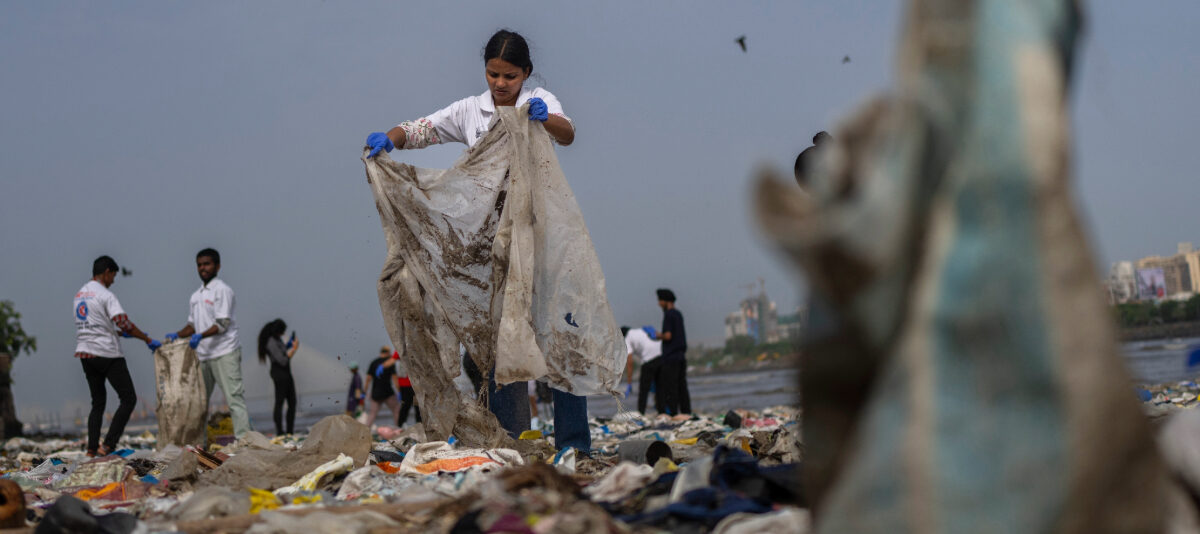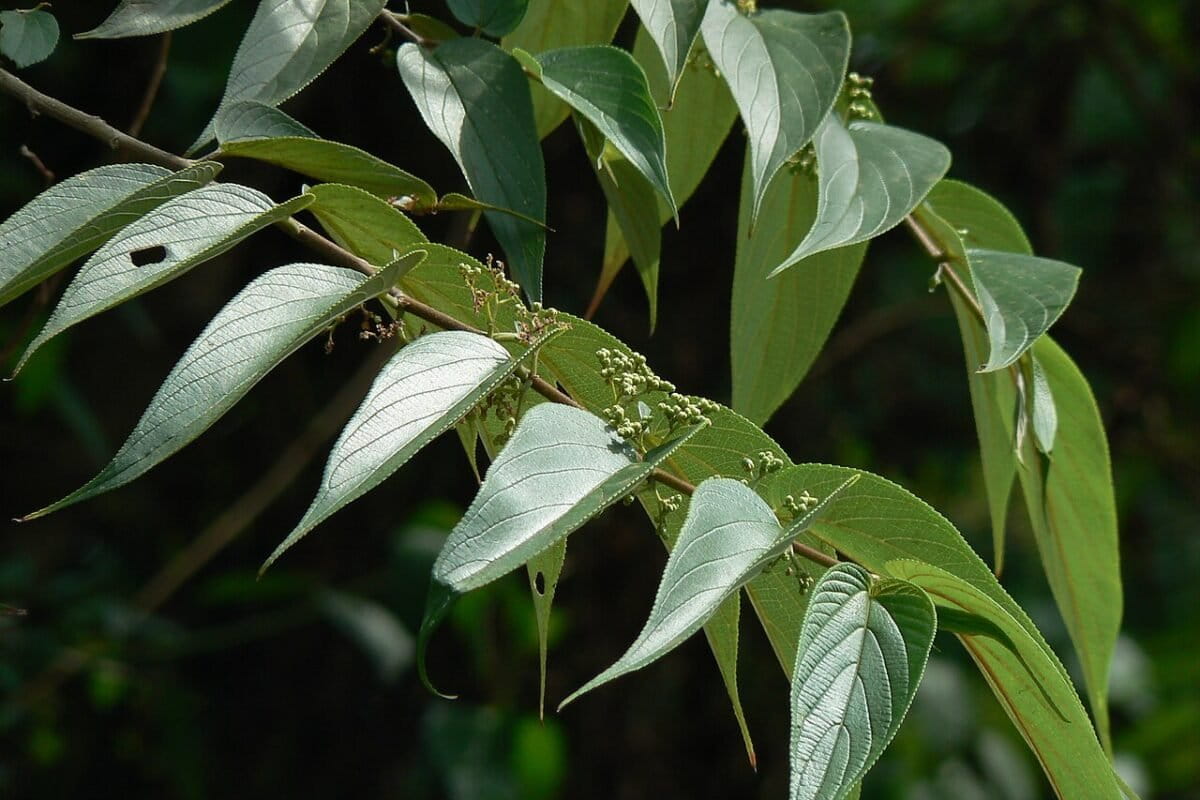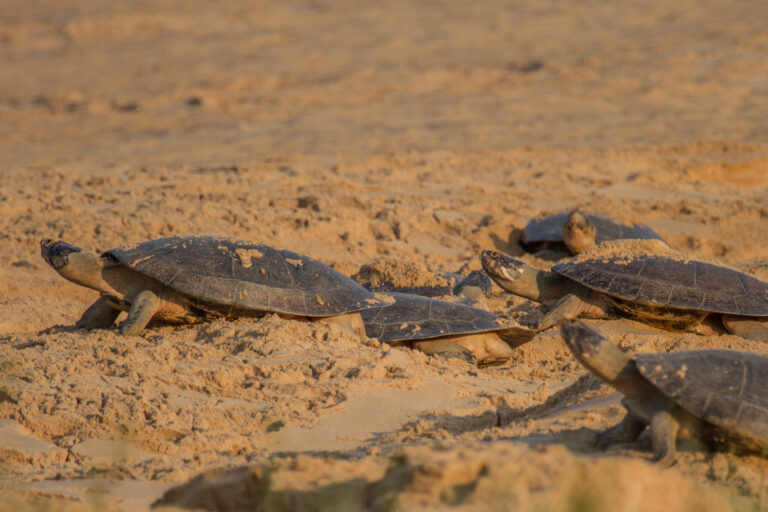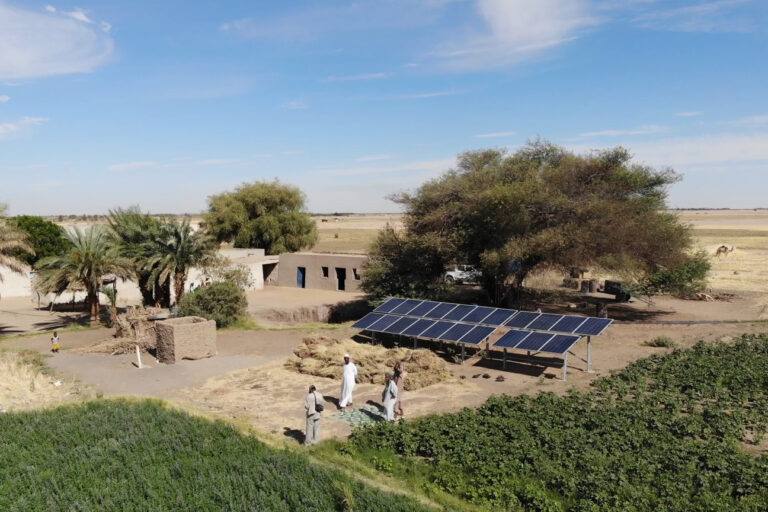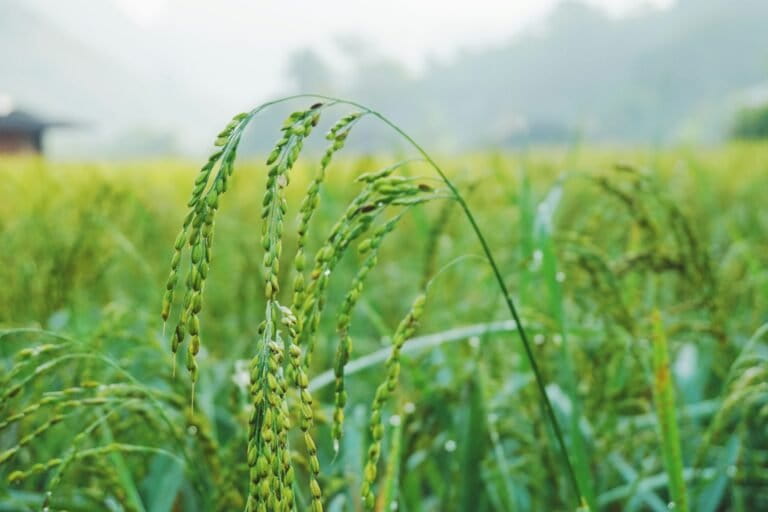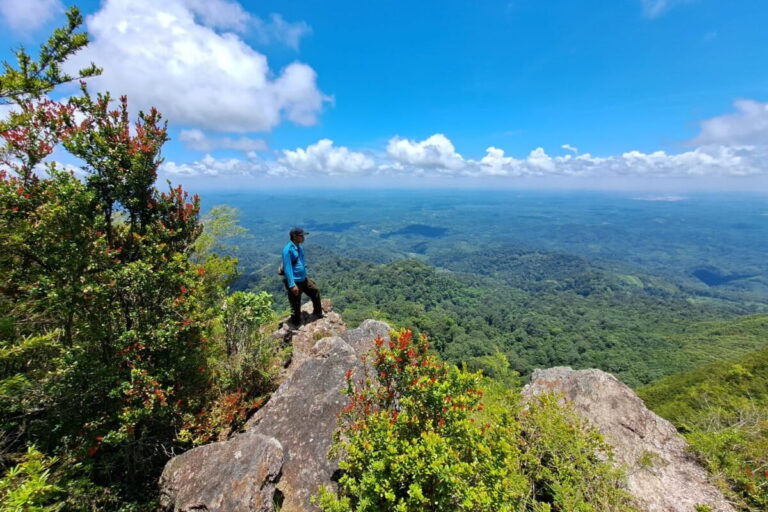- The Critically Endangered mountain gorilla (Gorilla beringei beringei), has been brought back from extinction’s brink in Rwanda, with numbers in the Virunga Mountains around Volcanoes National Park estimated at 604 individuals in 2016, up from 480 in 2010. But long-time observers say climate change is bringing new survival challenges to the area.
- Longer and deeper droughts in recent years have caused serious water shortages, which impact both local farmers and the mountain gorillas. People now must often go deep into the park to find clean water, which increases the likelihood of contact with the great apes, which increases the likelihood for the transfer of human diseases to the animals.
- Hotter temps and dryer conditions could also pressure farmers to move into gorilla habitat in future, as they seek more productive cropland at higher altitudes. Also, as the climate changes, bamboo availability may be decreasing, depriving gorillas of a favorite food. This could force troops to forage outside the park in croplands, possibly leading to conflict.
- Forced changes in diet could impact gorilla nutrition, making the great apes more susceptible to disease. A major disease outbreak could be disastrous due to low population numbers. Scientists urge more research to understand how climate change affects human behavior, which then affects gorillas, and how the fate of the two primates intertwines.

The mountain gorilla (Gorilla beringei beringei) is one of humanity’s closest relatives, and the largest primate to roam the rainy, high volcanic habitat of Rwanda. Recent conservation efforts have brought this Critically Endangered, charismatic species back from the brink of extinction. But now these great apes, and the people who live near them, face a slower moving, but more insidiously invasive threat – a changing climate.
“When we talk about climate change, we need to understand that what happens to us is what happens to the gorillas,” explained Dr. Jean-Bosco Noheri, a veterinarian at Gorilla Doctors, a team that provides direct, hands-on care to gorillas in the African wild.
Volcanoes National Park, home to the mountain gorillas, is located in a very densely populated rural region of northwestern Rwanda. Known for its successful ecotourism program, the park is partially encircled by croplands whose subsistence and commercial farmers till the highly fertile volcanic soils. Entry to the park and to see the mountain gorillas is heavily restricted, with fees to tourists as high as $1,500 for just an hour with the great apes.
The national park and the surrounding region is a complex landscape, where gorilla and human fates intertwine, and where global warming is now starting to make its impacts felt in myriad, sometimes complicated and unexpected ways.
“The question is not about whether climate change will affect mountain gorillas directly,” explained David Greer, Great Apes Coordinator at the World Wildlife Fund who has worked with gorillas in both the Central African Republic and Rwanda. “We need to understand how climate change is affecting human behavior, which then affects mountain gorillas.”
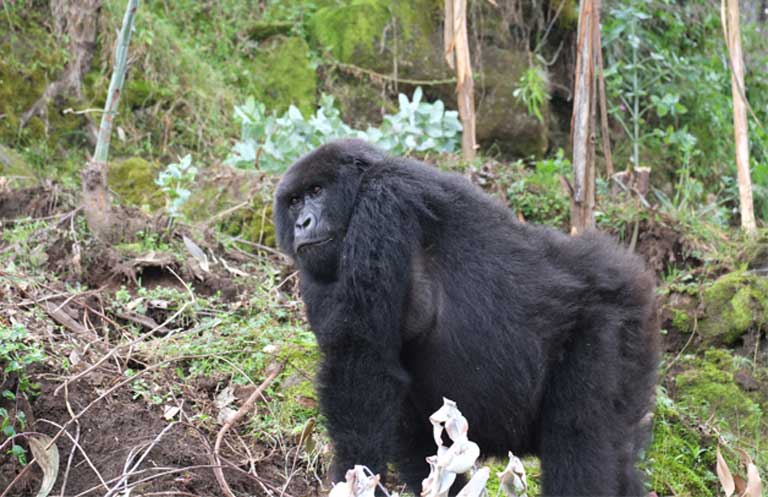
Search for water drives people into gorilla habitat
For farmers living near Volcanoes National Park, the most-tangible effect of climate change so far is escalating drought, and decreased access to clean water during intensifying dry times.
“Even a hundred years from now, we will not be able to say that a single event is caused entirely by climate change. But, by virtue of the atmosphere holding more moisture due to warmer temperatures, almost every weather event is potentially being affected by climate change [today],” said Nikhil Advani, Lead Specialist of Climate, Communities and Biodiversity at the World Wildlife Fund. “So while we can’t say a drought or hurricane is caused by climate change, we know that it is being exacerbated or super-charged by climate change.”
Many local farmers, necessarily acute observers of rainfall patterns, have already noted East Africa’s deepening periods of drought. “There have been many changes to the dry season. Before the dry season used to come in July, and even in mid-July we would get rain for 2-3 days,” said Vestine Mukanoheri, a farmer from the Gahunga Sector. “Now, the dry season starts in May and goes up to October. This [negatively] affects the water we have access to.”
Vestine’s adaption to worsening drought has received an indirect assist from the gorillas, whose habitat is nearby. She meets her household needs via a water tank next to her home, provided by the International Gorilla Conservation Programme, an NGO dedicated to the conservation of mountain gorillas and to sustainable livelihoods for communities. The tank collects rainwater in wet times, and Vestine relies on the stored water for basic needs during the intense dry season.
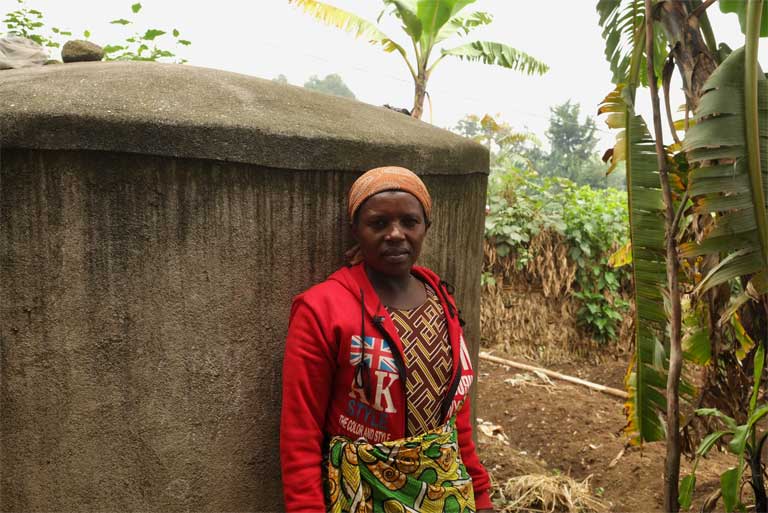
But not everyone has access to a water tank. According to Gaisserie, a farmer from Kinigi Sector, the lack of access during the severe August dry season causes many local farmers to venture into gorilla habitat seeking clean sources of water. Volcanoes National Park has streams, lakes and ponds that can provide water to communities. In dry times, “It is critical to fetch water in the park. We go every day to the park in August as a group,” said Gaisserie. “We sometimes see gorillas when we go into the park. Buying water is expensive and not everyone can afford it.”
But as climate change worsens, bringing longer droughts, easily-accessible water sources are drying up near the park’s edge. “I have worked in Volcanoes National Park for 22 years, both as a gorilla tracker and as park staff. I know exactly where the water was before, and today, those spots have dried up,” said Benjamin Mugabukomeye, Country Director at the International Gorilla Conservation Programme.
As a result, farmers like Gaisserie must go deeper and deeper into the protected area in search of water, which often means going higher up the volcanoes, which increases the likelihood of contact between people and gorillas.
However, increasing the number of people entering and penetrating deep into the park without controlled access can be problematic for gorillas. “Women go into the park with babies and children for water, and this can affect disease transmission. Kids bring diseases, sneezes and coughs. There has been an increase in respiratory disease outbreak in gorillas which has caused deaths,” said Noheri.
For park management and Rwanda’s government, stopping farmers from entering the park for water is not seen as a solution as water is a basic human need. Instead, Volcanoes National Park manager Prosper Uwingeli asserts that more and better monitoring and control systems to regulate the flow of people into the park for water are needed.
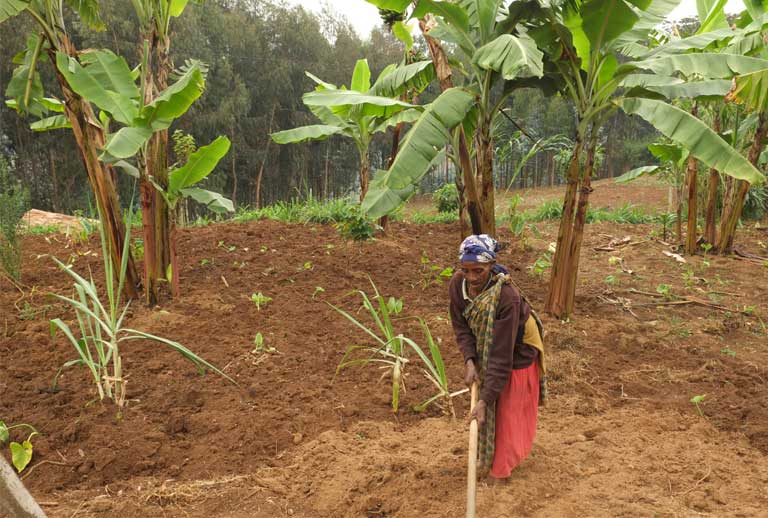
“We currently do not have systematic monitoring and control measures in place regarding how many people go into the park for water, and what they do when they get there. We know from our rangers where people are fetching water, and they mostly do it during the dry season,” he said. “We also need more scientific evidence about whether the shortage of water is related to climate change, and whether people going into the park for water has an impact on disease outbreak in gorillas.”
Reports by non-governmental organizations paint an increasingly serious pictures of future climate vulnerability for Rwanda: high temperatures and lower overall rainfall are projected in the near term, and more variable rainfall with more frequent storms are forecast for the long term.
The increased heat and erratic rainfall is already impacting the region’s crops. “For farmers near Volcanoes, the most tangible effect of climate change [so far] is the reduced number of Irish potatoes. Their crops are affected by the long dry season and the unpredictable weather,” said Mugabukomeye. “It’s a big issue for farmers to know when to plant crops for good production.” The United Nations Intergovernmental Panel on Climate Change has predicted very high risks of reduced crop productivity due to climate change in Africa. And as with the water shortages, such changes could impact great apes, increasing pressure on gorilla habitat as farmers might seek new, fertile cropland higher up the mountains to increase their productivity.

Climate change bringing dietary shifts and disease to mountain gorillas
People aren’t the only climate change-related problem gorillas are facing. “Changes in temperature and rainfall will have an impact on gorillas’ habitat and food. Gorillas are flexible in their diet, but they will need to adjust to these changes,” said Dr. Winnie Eckardt, research manager at the Karisoke Research Center at The Dian Fossey Gorilla Fund International. Karisoke scientists have been working with mountain gorilla populations since the 1960s.
“I have a general feeling from being in this park since 2004 that bamboo shoot availability has gone down,” Eckardt said. Bamboo shoots are seasonal – only available a few months out of the year – and the plants are concentrated along park boundaries at lower altitudes. During the peak growing season, some gorilla groups feed almost exclusively on bamboo shoots and spend 90 percent of their time in the bamboo zone.
The proximity of this bamboo to the park’s borders is a problem, as the amorphous borders serve as a gateway for gorillas who move into farmers’ fields, seeking food – particularly their favorites: bamboo shoots and eucalyptus. This heightens pressure on farmers’ crops and livelihoods, already under strain because of lower productivity due to drought and heat brought by climate change.
“Bamboo is a key food plant for gorillas, and the natural regeneration of bamboo seems to be changing over time,” said Eckardt. “But we need more research about this change and the connection to climate change.”
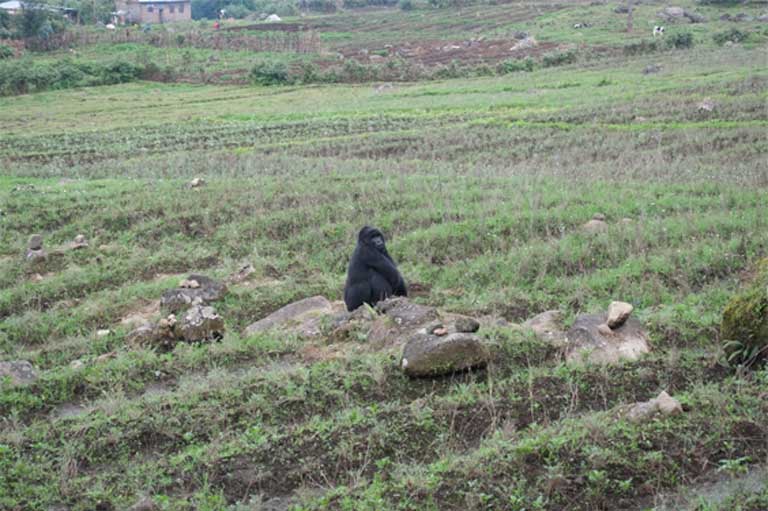
Studies have clearly shown shifts in the availability of some of the gorillas’ most frequently-consumed foods. A vine called Galium is a favorite among the great apes, but the plant saw a 50 percent decline in biomass between 1989 and 2010. Other key plant species that gorillas eat have either shifted downslope or moved higher up the mountains over time, and some scientists agree that it is reasonable to assume that these altitudinal shifts were caused by changes in climatic patterns.
Another concerning factor for scientists is the relation between climate and great ape diseases.
“Climate change has an impact on the viability of gorilla populations. If there are any changes to food availability, then gorillas’ nutrition and food intake is affected, which makes them more sensitive to diseases,” said Noheri.
Over the past twenty years, there has been an increase in the frequency of respiratory infections in mountain gorillas. Researchers and veterinarians at Gorilla Doctors are currently conducting research to examine the potential factors behind these infectious outbreaks, including changes in weather, temperature increases, and more people in the park.

Any increase in disease could be potentially catastrophic to the great apes. While the most recent census put the estimated number of mountain gorillas in the Virunga Mountains around Volcanoes National Park at 604 individuals in 2016 – up from 480 in 2010 – the species is still listed as Critically Endangered by the IUCN, with a small population and low genetic diversity.
“If there are any new diseases, and the population is under more stress due to longer periods of heat, heavy rain – new pathogens and diseases in a short time can do a lot of damage to the gorillas,” said Eckardt.
“The capacity to react to disease is a challenge for such a small population of gorillas. Their habitat is also small, and if there are traumatic and fast environmental changes, can they adapt? These are open questions and areas that need to be studied more deeply with regular and consistent monitoring,” she added.

How will mountain gorillas respond to long-term climatic shifts?
Volcanoes National Park is part of a larger region called the Albertine Rift, one of the most biodiverse spots in Africa. Climate change projections for the rift region are dire, with a recent study anticipating that 75 percent of the suitable habitat for its endemic species will disappear by 2080, with most areas of suitable habitat shifting upwards into the mountains.
For the high elevation, volcanic ranges that mountain gorillas inhabit, climate model projections indicate warmer temperatures and more rainfall across the next few decades. This increased warming would likely force the great apes to move higher and higher, where they would face pressure not just from other gorilla groups competing for resources, but also from humans seeking higher elevations for better livelihoods.
Where will the gorillas go if the peaks of the mountains become too warm? Dr. James Thorne, a landscape ecologist from University of California, Davis, researched the climatology of the region for three years to try and understand the potential impacts of climate change on mountain gorillas. “If the park area gets warmer and the vegetation dries out, there might be a reduction in the body size of the gorillas,” he speculated.
There is also a chance that gorillas might be able to adapt to warmer temperatures, if their protected area was enlarged. “Our study found that if the park is expanded downhill, it would allow for a larger population of gorillas. Given the warming predicted in our models, it’s an unusual result and safe bet that gorillas might be able to adapt and survive in the downhill parts of Volcanoes National Park,” Thorne added.

However, region-specific and long-term climate data remains sparse. “Climate data in this region is limited, with most data going back ten years or so,” said Michel Masozera, Deputy Leader for Wildlife in Africa at the World Wildlife Fund. The absence of a long-term data record makes accurate area-specific climate projections difficult. “One way to assess impact could be to look at available climate data and relate it to data on gorilla home range and patterns of food availability,” he added.
Scientists suggest that the most serious risk to the survival of primate populations comes from the synergistic effects of multiple stressors, including a changing climate and other extinction drivers, such as deforestation, disease, changes in nutrition, and declining health of ecosystems. A high-impact threat remains the introduction of diseases through pathogens; propelled by climate change, disease could abruptly threaten the entire population of mountain gorillas.
Noheri ultimately sees climate change as having an impact on the survivability and health of both human and mountain gorilla populations: “We know this because we have been working with gorillas for more than fifty years. You see deforestation, you see changes in food availability, an increase in people in the park and increase in diseases. We need more scientific evidence, but we work in the forest every day – we know that climate change is behind these changes,” he said.
Elham Shabahat is a 2017 Pulitzer Center fellow, and her reporting project was supported by the Pulitzer Center and the Yale Program on Climate Change Communication.
FEEDBACK: Use this form to send a message to the author of this post. If you want to post a public comment, you can do that at the bottom of the page.




